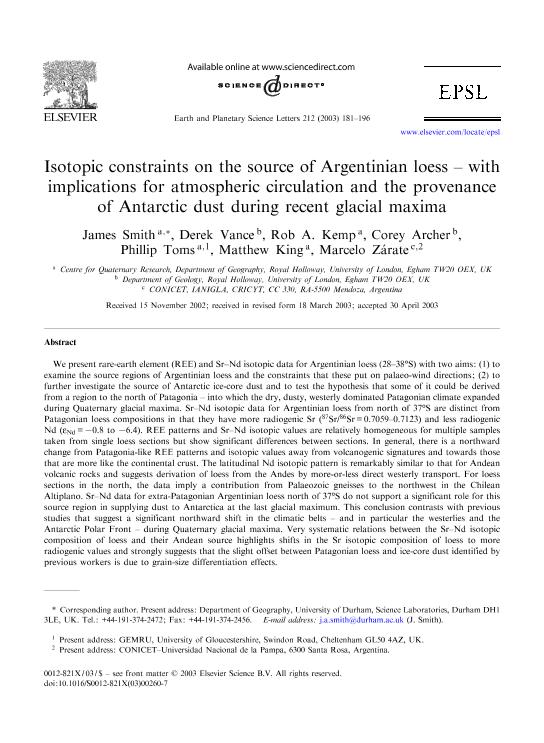Mostrar el registro sencillo del ítem
dc.contributor.author
Smith, James
dc.contributor.author
Vance, Derek
dc.contributor.author
Kemp, Rob A.
dc.contributor.author
Archer, Corey
dc.contributor.author
Toms, Phillip
dc.contributor.author
King, Matthew
dc.contributor.author
Zárate, Marcelo Arístides

dc.date.available
2019-08-16T18:48:51Z
dc.date.issued
2003-07
dc.identifier.citation
Smith, James; Vance, Derek; Kemp, Rob A.; Archer, Corey; Toms, Phillip; et al.; Isotopic constraints on the source of Argentinian loess - With implications for atmospheric circulation and the provenance of Antarctic dust during recent glacial maxima; Elsevier Science; Earth and Planetary Science Letters; 212; 1-2; 7-2003; 181-196
dc.identifier.issn
0012-821X
dc.identifier.uri
http://hdl.handle.net/11336/81752
dc.description.abstract
We present rare-earth element (REE) and Sr-Nd isotopic data for Argentinian loess (28-38°S) with two aims: (1) to examine the source regions of Argentinian loess and the constraints that these put on palaeo-wind directions; (2) to further investigate the source of Antarctic ice-core dust and to test the hypothesis that some of it could be derived from a region to the north of Patagonia - into which the dry, dusty, westerly dominated Patagonian climate expanded during Quaternary glacial maxima. Sr-Nd isotopic data for Argentinian loess from north of 37°S are distinct from Patagonian loess compositions in that they have more radiogenic Sr (87Sr/86Sr=0.7059-0.7123) and less radiogenic Nd (ε Nd =-0.8 to -6.4). REE patterns and Sr-Nd isotopic values are relatively homogeneous for multiple samples taken from single loess sections but show significant differences between sections. In general, there is a northward change from Patagonia-like REE patterns and isotopic values away from volcanogenic signatures and towards those that are more like the continental crust. The latitudinal Nd isotopic pattern is remarkably similar to that for Andean volcanic rocks and suggests derivation of loess from the Andes by more-or-less direct westerly transport. For loess sections in the north, the data imply a contribution from Palaeozoic gneisses to the northwest in the Chilean Altiplano. Sr-Nd data for extra-Patagonian Argentinian loess north of 37°S do not support a significant role for this source region in supplying dust to Antarctica at the last glacial maximum. This conclusion contrasts with previous studies that suggest a significant northward shift in the climatic belts - and in particular the westerlies and the Antarctic Polar Front - during Quaternary glacial maxima. Very systematic relations between the Sr-Nd isotopic composition of loess and their Andean source highlights shifts in the Sr isotopic composition of loess to more radiogenic values and strongly suggests that the slight offset between Patagonian loess and ice-core dust identified by previous workers is due to grain-size differentiation effects.
dc.format
application/pdf
dc.language.iso
eng
dc.publisher
Elsevier Science

dc.rights
info:eu-repo/semantics/openAccess
dc.rights.uri
https://creativecommons.org/licenses/by-nc-sa/2.5/ar/
dc.subject
Antarctica
dc.subject
Ice-Core
dc.subject
Loess
dc.subject
South America
dc.subject
Sr-Nd
dc.subject.classification
Geoquímica y Geofísica

dc.subject.classification
Ciencias de la Tierra y relacionadas con el Medio Ambiente

dc.subject.classification
CIENCIAS NATURALES Y EXACTAS

dc.title
Isotopic constraints on the source of Argentinian loess - With implications for atmospheric circulation and the provenance of Antarctic dust during recent glacial maxima
dc.type
info:eu-repo/semantics/article
dc.type
info:ar-repo/semantics/artículo
dc.type
info:eu-repo/semantics/publishedVersion
dc.date.updated
2019-08-15T16:21:40Z
dc.journal.volume
212
dc.journal.number
1-2
dc.journal.pagination
181-196
dc.journal.pais
Países Bajos

dc.journal.ciudad
Amsterdam
dc.description.fil
Fil: Smith, James. University of London; Reino Unido
dc.description.fil
Fil: Vance, Derek. University of London; Reino Unido
dc.description.fil
Fil: Kemp, Rob A.. University of London; Reino Unido
dc.description.fil
Fil: Archer, Corey. University of London; Reino Unido
dc.description.fil
Fil: Toms, Phillip. University of London; Reino Unido
dc.description.fil
Fil: King, Matthew. University of London; Reino Unido
dc.description.fil
Fil: Zárate, Marcelo Arístides. Consejo Nacional de Investigaciones Científicas y Técnicas. Centro Científico Tecnológico Conicet - Mendoza. Instituto Argentino de Nivología, Glaciología y Ciencias Ambientales. Provincia de Mendoza. Instituto Argentino de Nivología, Glaciología y Ciencias Ambientales. Universidad Nacional de Cuyo. Instituto Argentino de Nivología, Glaciología y Ciencias Ambientales; Argentina. Consejo Nacional de Investigaciones Científicas y Técnicas. Instituto de Ciencias de la Tierra y Ambientales de La Pampa. Universidad Nacional de La Pampa. Facultad de Ciencias Exactas y Naturales. Instituto de Ciencias de la Tierra y Ambientales de La Pampa; Argentina
dc.journal.title
Earth and Planetary Science Letters

dc.relation.alternativeid
info:eu-repo/semantics/altIdentifier/url/https://www.sciencedirect.com/science/article/pii/S0012821X03002607
dc.relation.alternativeid
info:eu-repo/semantics/altIdentifier/doi/https://doi.org/10.1016/S0012-821X(03)00260-7
Archivos asociados
